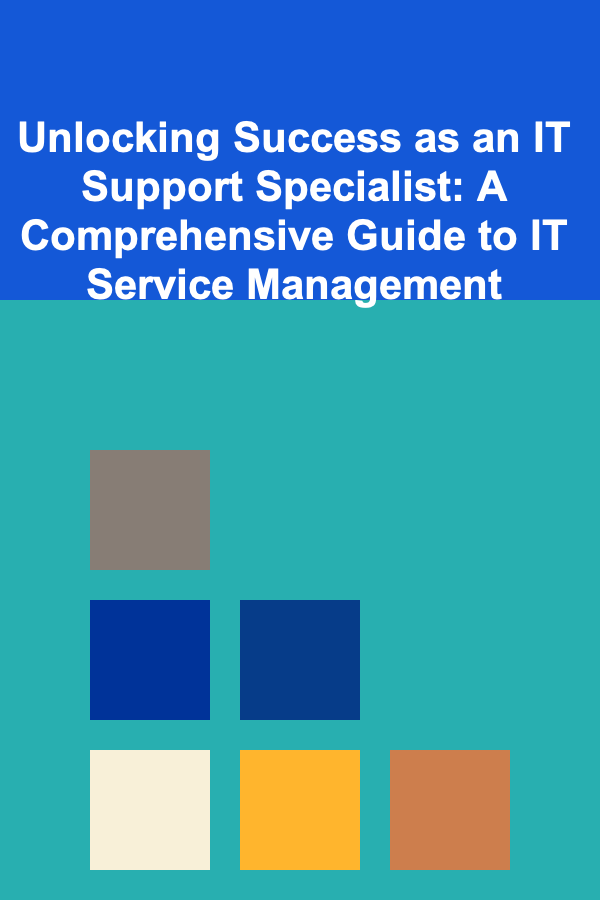
Unlocking Success as an IT Support Specialist: A Comprehensive Guide to IT Service Management
ebook include PDF & Audio bundle (Micro Guide)
$12.99$9.99
Limited Time Offer! Order within the next:

In today's rapidly evolving technology landscape, the role of IT support specialists has become more crucial than ever. As organizations increasingly depend on their IT infrastructure for business operations, IT support specialists are tasked with not only maintaining hardware and software systems but also ensuring that end-users experience minimal disruptions. IT Service Management (ITSM) plays a key role in achieving these goals by providing structured approaches to designing, delivering, managing, and improving IT services.
This comprehensive guide delves into the essentials of ITSM, its impact on IT support, and actionable steps for IT support specialists to unlock success in this ever-demanding role. Whether you're just starting out or are a seasoned professional, understanding the principles of ITSM can significantly enhance your ability to deliver high-quality support, resolve issues efficiently, and contribute to the overall success of your organization.
The Importance of IT Service Management (ITSM)
IT Service Management (ITSM) is a set of practices and processes that align IT services with the needs of the business. Unlike traditional reactive IT support, which focuses only on solving problems as they arise, ITSM takes a proactive approach to ensure that IT services are delivered effectively, consistently, and with continuous improvement.
In essence, ITSM aims to deliver the best possible user experience by ensuring that IT services are well-defined, managed, and aligned with business objectives. By adopting a structured approach to IT support, ITSM provides several benefits:
- Improved Service Quality: By formalizing processes and setting clear expectations, ITSM ensures that IT services are delivered with consistency and reliability.
- Increased Efficiency: ITSM streamlines workflows, reducing time spent on repetitive tasks and minimizing downtime.
- Better Communication: A structured service delivery model fosters clearer communication between IT support teams and business users, reducing misunderstandings and improving collaboration.
- Proactive Problem Solving: Rather than just reacting to incidents, ITSM encourages the identification and resolution of underlying issues to prevent future disruptions.
For IT support specialists, embracing ITSM principles is essential in ensuring that their services are efficient, responsive, and aligned with business goals. But how can an IT support specialist effectively implement these principles?
Core ITSM Processes Every IT Support Specialist Should Know
There are several key processes within ITSM that an IT support specialist must understand and apply to ensure success. Below, we explore the core processes that drive ITSM and how they impact the role of IT support.
1. Incident Management
Incident management is the process of managing and resolving IT issues that cause service interruptions or degrade the user experience. The goal is to restore normal service operation as quickly as possible with minimal disruption.
Best Practices:
- Efficient Ticketing System: Utilize a ticketing system to log, categorize, and prioritize incidents. This ensures issues are tracked and managed in an organized manner.
- Clear Communication: Maintain clear communication with users throughout the resolution process. Set expectations on when and how issues will be resolved.
- Root Cause Analysis: While resolving incidents, always aim to identify the underlying causes to prevent similar issues from recurring.
2. Problem Management
Problem management is focused on identifying, diagnosing, and eliminating the root causes of recurring incidents. This proactive approach helps prevent future incidents and minimizes their impact on service delivery.
Best Practices:
- Trend Analysis: Regularly analyze incident data to spot patterns and trends. Look for recurring issues and investigate their root causes.
- Collaboration with Development: Work closely with development or engineering teams to address software bugs, hardware issues, or system flaws.
- Implement Permanent Solutions: After identifying the root cause, implement long-term solutions rather than relying on temporary workarounds.
3. Change Management
Change management ensures that any changes to IT systems, processes, or infrastructure are introduced in a controlled and systematic manner to minimize risks and disruptions.
Best Practices:
- Standardized Procedures: Create standard operating procedures (SOPs) for implementing changes. This ensures that changes are planned, tested, and deployed effectively.
- Risk Assessment: Always conduct a thorough risk assessment before implementing any changes. This helps mitigate the potential negative impact on IT services.
- Clear Communication: Communicate changes well in advance to users and stakeholders. Proper communication ensures everyone is aware of the changes and prepared for them.
4. Service Request Management
Service request management deals with managing requests from end-users for standard IT services such as software installations, password resets, or access permissions. It is about ensuring users can easily request services without going through a complex process.
Best Practices:
- User Self-Service Portals: Implement self-service portals that allow users to submit requests and track their progress without the need for direct interaction with IT support.
- Standardization: Create standard request categories to streamline the process. Standardizing requests helps ensure quick and efficient service delivery.
- Efficiency and Automation: Automate routine tasks like password resets or account provisioning to save time and improve efficiency.
5. Configuration Management
Configuration management involves maintaining an up-to-date record of all IT assets, including hardware, software, and network components. This process ensures that all systems are properly configured and can be managed effectively.
Best Practices:
- Accurate CMDB (Configuration Management Database): Keep an accurate and up-to-date CMDB that tracks all hardware, software, and system configurations.
- Consistency: Ensure that all configurations are standardized across systems to avoid errors or incompatibilities.
- Regular Audits: Conduct regular audits to verify that configurations remain aligned with business requirements and industry standards.
Key Skills for IT Support Specialists in an ITSM Framework
The ITSM framework requires IT support specialists to have a diverse set of skills. It's not just about resolving incidents; it's about managing IT services in a way that is structured, efficient, and aligned with business needs. Below are some critical skills that IT support specialists should focus on to excel within an ITSM framework.
1. Technical Proficiency
While ITSM processes provide a structured approach to managing IT services, IT support specialists must still possess strong technical knowledge of hardware, software, networking, and security. Proficiency in troubleshooting and resolving technical issues is the foundation of any IT support role.
- Software Troubleshooting: Deep knowledge of common operating systems, applications, and tools allows IT support specialists to diagnose and resolve software-related incidents effectively.
- Hardware Knowledge: An understanding of hardware components, from servers to personal devices, is essential for diagnosing issues that could be hardware-related.
- Networking: Familiarity with networking concepts such as TCP/IP, DNS, DHCP, and VPNs is critical in resolving connectivity and performance issues.
2. Problem-Solving and Analytical Thinking
Problem-solving is one of the most critical skills for IT support specialists. They must be able to identify the root causes of issues and propose effective solutions.
- Root Cause Analysis: The ability to dig deeper into issues, identify underlying causes, and eliminate recurring problems is central to problem management in ITSM.
- Creative Thinking: Finding innovative solutions to complex problems requires thinking outside the box and considering all potential factors.
3. Communication Skills
Effective communication is key to managing IT services and interacting with end-users. IT support specialists must be able to explain technical concepts to non-technical users and keep them informed during incident resolutions.
- Clear Explanations: Users may not understand the technical details behind an issue. Being able to explain the problem and the steps to resolve it in a clear, understandable way is crucial.
- Empathy: IT support specialists often handle frustrated or stressed users. Being empathetic and maintaining professionalism can help build rapport and improve user satisfaction.
4. Time Management and Prioritization
In IT support, issues can range from minor inconveniences to major service outages. IT support specialists must be able to prioritize tasks effectively to ensure that critical issues are addressed promptly while still providing timely solutions for less urgent matters.
- Ticket Prioritization: Use ITSM best practices to categorize and prioritize tickets based on their impact and urgency.
- Managing Multiple Tasks: IT support specialists often juggle multiple incidents and service requests simultaneously. Strong time management skills ensure that nothing falls through the cracks.
Best Practices for Implementing ITSM in Your Organization
While ITSM is a structured approach, successful implementation requires a commitment to continuous improvement and alignment with organizational goals. Here are some best practices for IT support specialists to implement ITSM in their organization:
1. Align ITSM with Business Objectives
Ensure that your ITSM processes are aligned with the broader goals of the organization. This ensures that IT services support and enhance business functions, rather than becoming a bottleneck.
2. Continuous Improvement
Adopt a mindset of continuous improvement. Regularly review your ITSM processes, gather feedback from users, and identify areas for optimization. ITSM frameworks like ITIL (Information Technology Infrastructure Library) emphasize the need for ongoing service improvements.
3. Use ITSM Tools Effectively
Leverage modern ITSM tools to streamline processes and automate routine tasks. Tools like ServiceNow, Jira Service Management, and BMC Remedy can enhance efficiency and help maintain a clear overview of service requests, incidents, and changes.
4. Train and Educate End-Users
User education is key to minimizing incidents. Provide users with training on basic troubleshooting steps, security practices, and how to effectively use IT support services. Well-educated users can help reduce the volume of service requests and incidents.
Conclusion
Becoming a successful IT support specialist in an ITSM framework requires a blend of technical expertise, process understanding, and effective communication. By adopting ITSM best practices and focusing on key processes such as incident management, problem management, and change management, IT support specialists can deliver high-quality, efficient services that align with business goals. Furthermore, the continuous application of problem-solving skills, time management, and a proactive approach to user satisfaction will ensure that IT services remain an invaluable resource for the organization.
By embracing ITSM, IT support specialists not only improve their technical capabilities but also contribute to the overall efficiency and success of their organization's IT operations.

How to Incorporate Inspirational Décor into Your Sewing Space
Read More
How to Organize Your Appliance Manuals and Warranties
Read More
How To Sketch Everyday Life: Urban Sketching
Read More
How to Protect Against Buffer Overflow Attacks
Read More
How to Control Your Data in Health and Fitness Apps
Read More
How To Boost Your Mental Well-being for Physical Health
Read MoreOther Products

How to Incorporate Inspirational Décor into Your Sewing Space
Read More
How to Organize Your Appliance Manuals and Warranties
Read More
How To Sketch Everyday Life: Urban Sketching
Read More
How to Protect Against Buffer Overflow Attacks
Read More
How to Control Your Data in Health and Fitness Apps
Read More